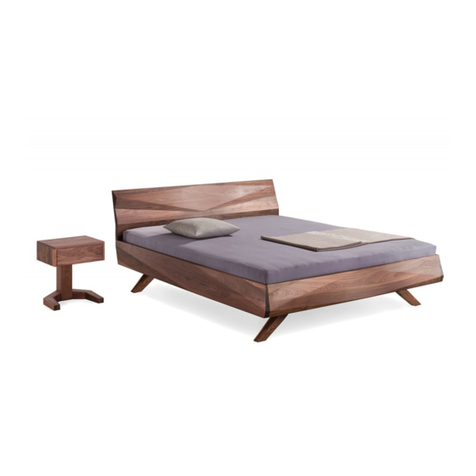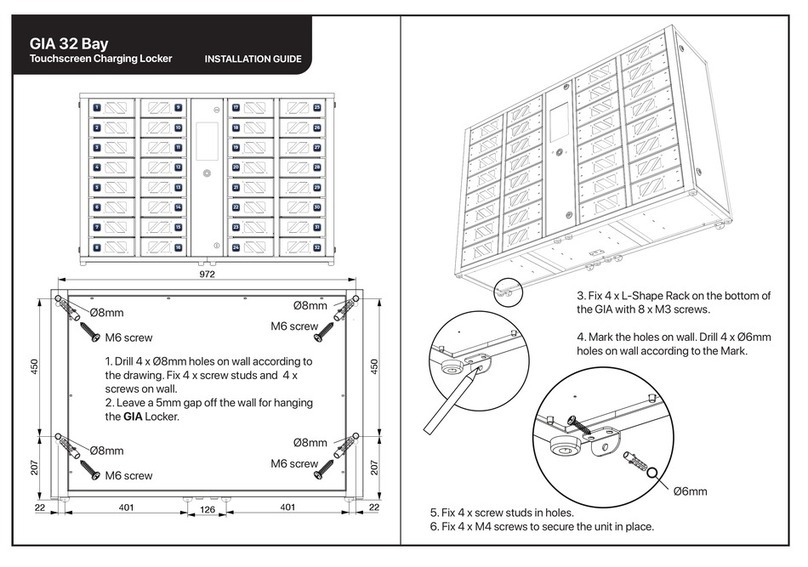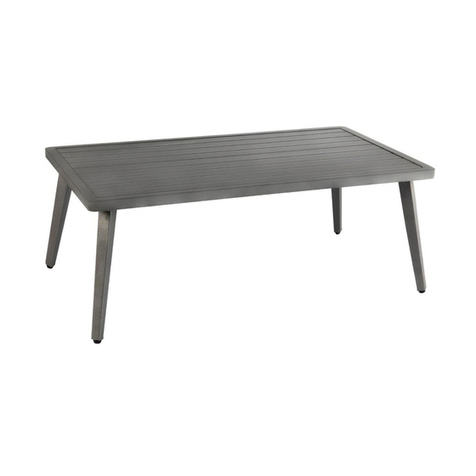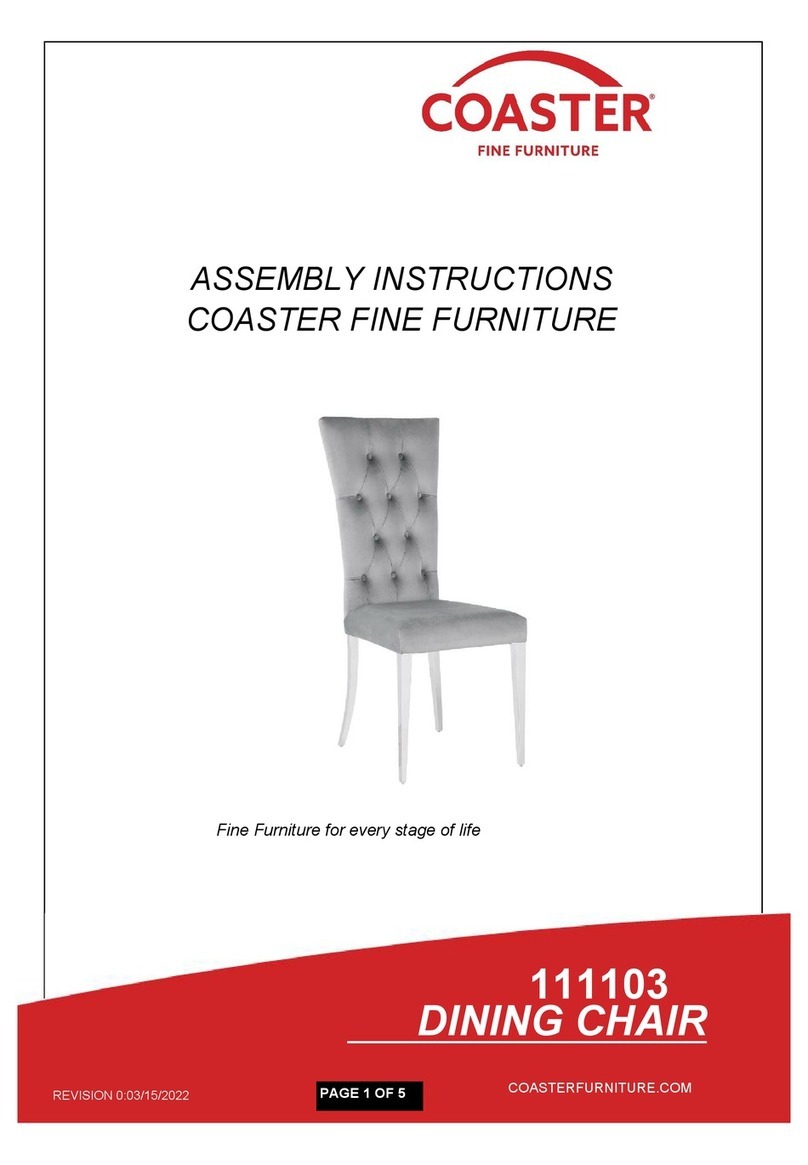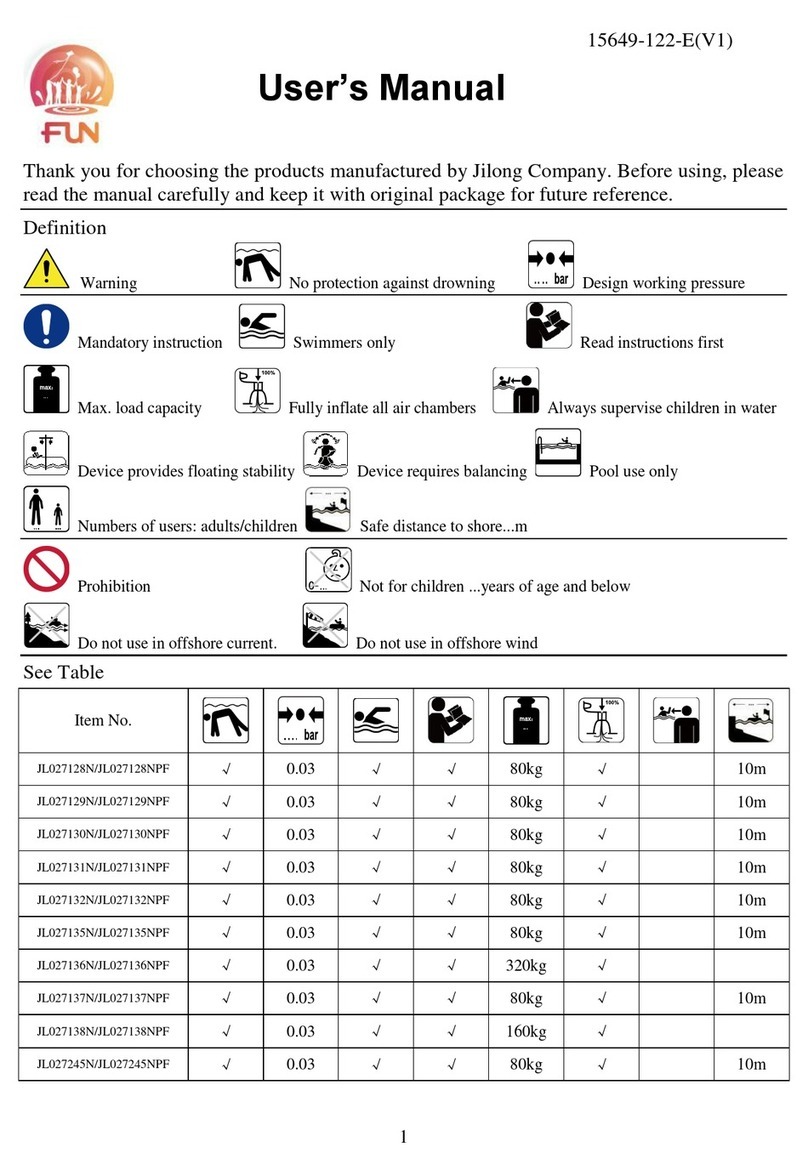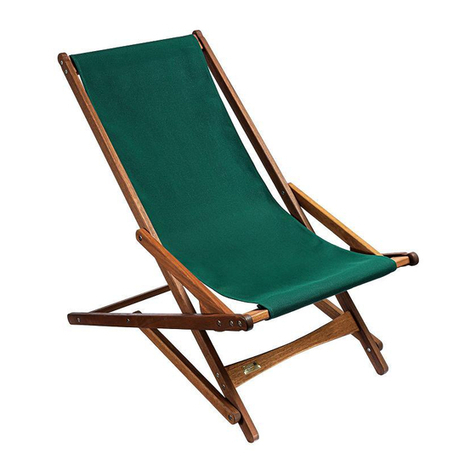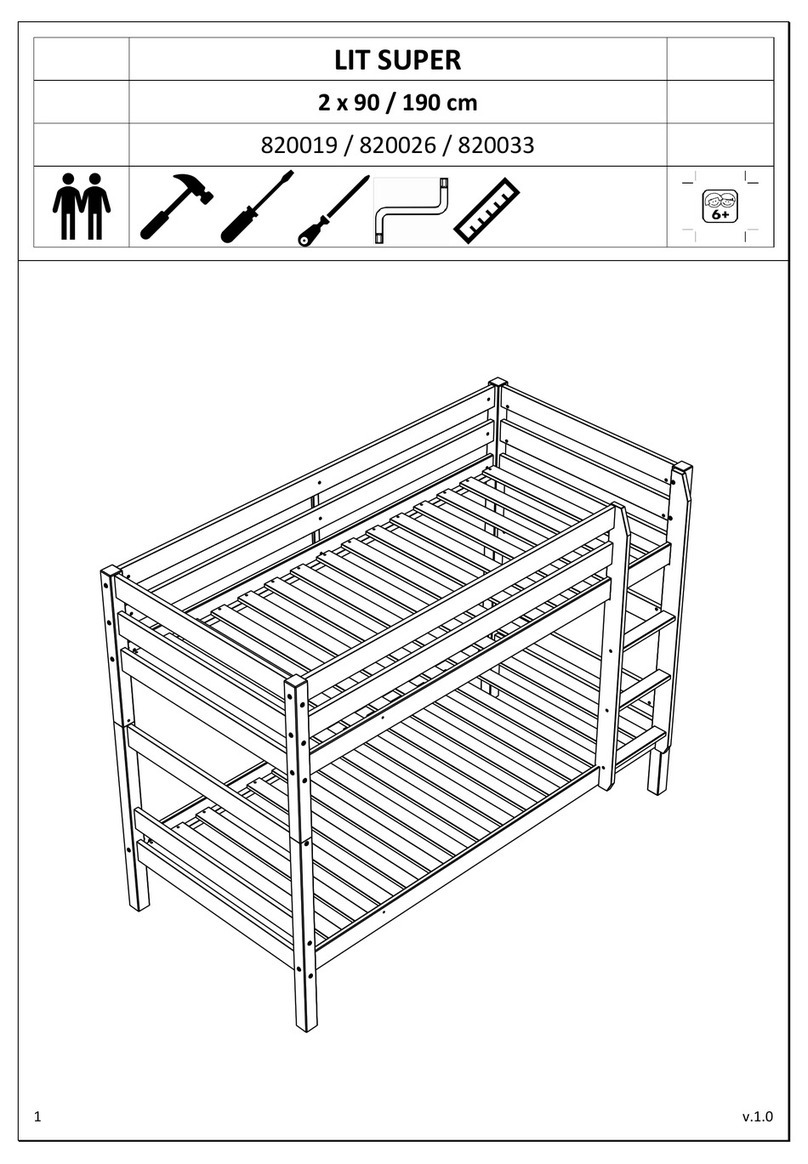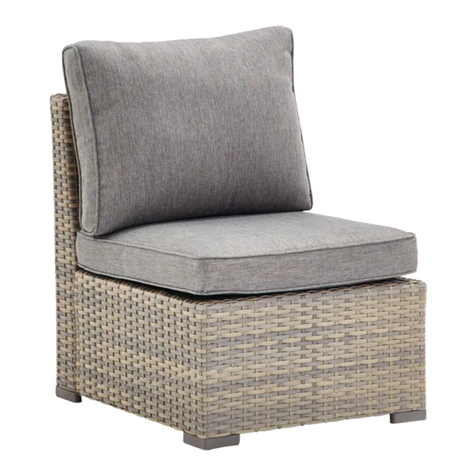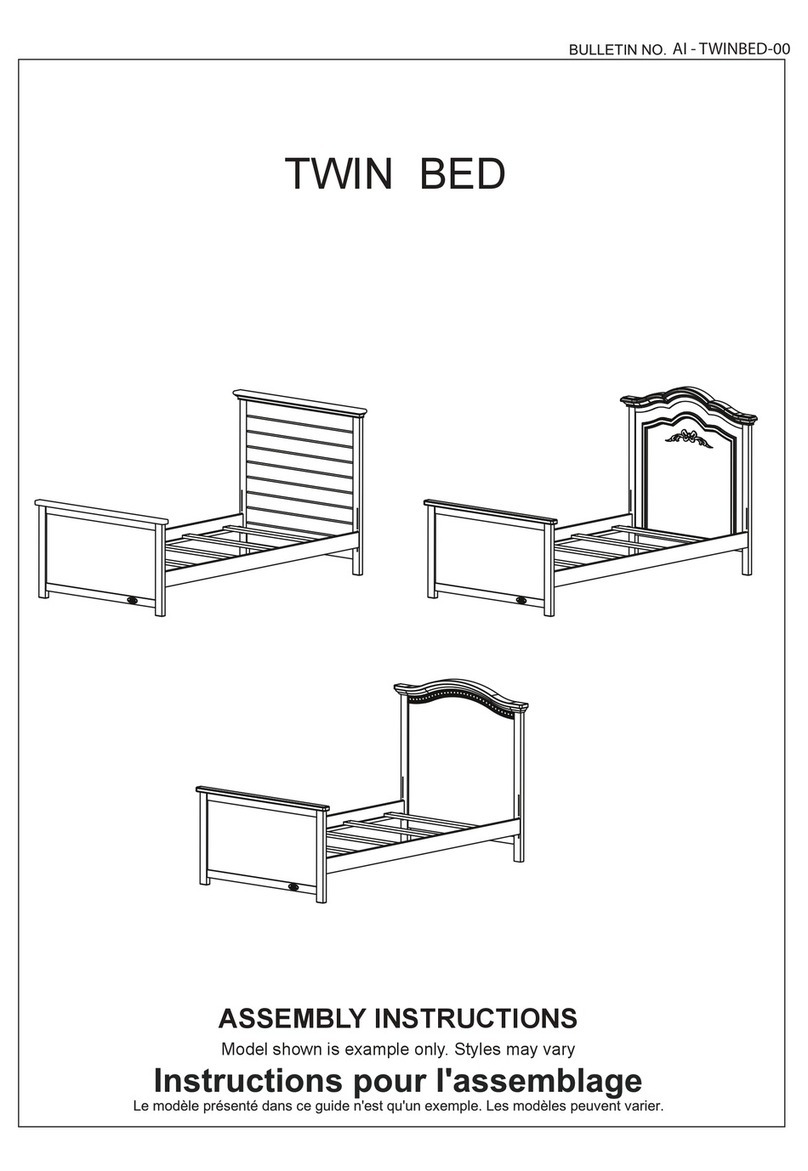Skytron ELITE Series User manual

Page59
ELITE SERIES SURGICALTABLES
MODEL ELITE 6002
MAINTENANCE MANUAL
INCLUDING BATTERY MODELS
REV 8/05

Page52

Page53
Table of Contents
SECTION I HYDRAULIC SYSTEM ...................................................................................................... 1
1-1. General........................................................................................................................................... 1
1-2. ComponentOperation .................................................................................................................... 2
a. Motor/PumpOperation ............................................................................................................. 2
b. Pressure Relief Valve .............................................................................................................. 2
c. Mini-Valves............................................................................................................................... 3
d. Mini-valve in Neutral Position ................................................................................................... 3
e. Mini-Valve Right Port Activated................................................................................................ 4
f. Mini-Valve Left Port Activated .................................................................................................. 4
g. Hydraulic Cylinders (Slave Cylinders) ..................................................................................... 5
h. Elevation Cylinder Return Circuit ............................................................................................. 6
i. Brake System........................................................................................................................... 7
j. Emergency Brake Release ...................................................................................................... 8
k. Flex/Reflex System ................................................................................................................... 8
1-3. Hydraulic Adjustments ................................................................................................................... 9
a. Fluid Level. ............................................................................................................................... 9
b. Bleeding The Hydraulic System ............................................................................................... 9
c. Pressure Relief Valve .............................................................................................................. 9
d. Speed Controls......................................................................................................................... 9
SECTION II MECHANICAL TABLE ADJUSTMENTS........................................................................ 11
2-1. Back Section Gear Mesh Adjustment ........................................................................................... 11
2-2. Hydraulic Cylinder Adjustment...................................................................................................... 11
a. Back Section ........................................................................................................................... 11
b. Leg Section ............................................................................................................................. 11
SECTION III HYDRAULIC TROUBLESHOOTING ............................................................................. 12
3-1. Precautions ................................................................................................................................... 12
3-2. Troubleshooting Notes .................................................................................................................. 12
3-3. ELEVATION DIAGNOSIS CHART .............................................................................................. 13
3-4. TRENDELENBURG DIAGNOSIS CHART.................................................................................. 14
3-5. LATERAL - TILT DIAGNOSIS CHART ........................................................................................ 15
3-6. FLEX SYSTEM DIAGNOSIS CHART.......................................................................................... 16
3-7. BACK SECTION DIAGNOSIS CHART ....................................................................................... 17
3-8. LEG SECTION DIAGNOSIS CHART .......................................................................................... 18
3-9. BRAKE CIRCUIT DIAGNOSIS CHART ..................................................................................... 19
3-10. Flexible Hose Identification and Placement................................................................................... 20
Although current at time of publication, SKYTRON's policy of continuous development makes this manual
subject to change without notice.
REV 8/05

Page54
Table of Contents (continued)
SECTION IV ELECTRICAL SYSTEM.................................................................................................. 22
4-1. General.......................................................................................................................................... 22
4-2. Components .................................................................................................................................. 22
4-3. Battery Model Components........................................................................................................... 22
SECTION V ELECTRICAL SYSTEM TROUBLESHOOTING ............................................................. 23
5-1. Troubleshooting Notes .................................................................................................................. 23
5-2. Main Switch................................................................................................................................... 23
5-3. Pendant Control ............................................................................................................................ 24
5-4. Relay Box...................................................................................................................................... 25
5-5. Solenoids....................................................................................................................................... 27
5-6. Motor/Pump Assembly.................................................................................................................. 29
5-7. Return To Level Micro-Switches................................................................................................... 31
5-8. Troubleshooting............................................................................................................................. 31
SECTION VI -6002B- BATTERY MODEL, ELECTRICAL TROUBLESHOOTING.............................. 36
6-1. General.......................................................................................................................................... 36
6-2. Troubleshooting Notes .................................................................................................................. 36
6-3. Main Switch................................................................................................................................... 37
6-4. Batteries ........................................................................................................................................ 37
6-5. Battery Charging Box/AC120V Transformer................................................................................. 38
6-6. Switch-Over Relay........................................................................................................................ 39
6-7. Pendant Control ............................................................................................................................ 40
6-8. Auxiliary Switches......................................................................................................................... 42
6-9. Relay Box...................................................................................................................................... 43
6-10.Main Wire Harness Continuity Tests............................................................................................. 45
6-11. Solenoids....................................................................................................................................... 46
6-12. Motor/Pump Assembly.................................................................................................................. 47
SECTION VII ELECTRICAL SYSTEM ADJUSTMENTS .................................................................... 48
7-1. Relay Box Adjustments Models 6002 & 6002B............................................................................ 48
WARNING
Indicatesapossibilityofpersonalinjury.
CAUTION
Indicates a possibility of damage to
equipment.
NOTE
Indicates important facts or helpful hints.

Page55
BASIC RECOMMENDED TOOLS:
1/8". 1/4" STRAIGHT BLADE SCREWDRIVERS
#2 PHILLIPS SCREWDRIVER
HYDRAULIC PRESSURE GAUGE SKYTRON P.N. 6-050-02
METRIC ALLEN® WRENCHES 1.5mm-8mm
ADJUSTABLE CRESCENT WRENCH
DIGITAL VOLTMETER, TRUE RMS
METRIC OPEN END WRENCHES 7mm-18mm
LEVEL (CARPENTERS)
BASIC RECOMMENDED MAINTENANCE PROCEDURES
The basic items notes below should be inspected at a minimal interval period of 6 months (dependant on
usage). For optimal usage, safety and longevity of the product, have it serviced only by an authorized
Skytron representative with authentic Skytron replacement parts.
• Check Power Cord (if applicable) • Inspect Articulating Joints
• Check Pendant Control (if applicable) • Inspect Table Tops
• Check Oil Level in Reservoir • Check Operational Times and Pressure Values
• Check For Hydraulic Leaks • Check Pressure Relief Valve Setting
• Check All Table Functions • Check Side Rails
• Check Velcro • Check Lateral Tilt Housing Bolts
• Inspect Leg and Head Section detachment mechanisms for proper operation
• Lubricate Elevation Slider Assembly with SKYTRON Slider Grease P/N D6-010-89
• Tighten X-Ray Top Stand-Offs, Use Loc-tite
• Lubricate Casters
• Check brake pads for wear and inspect brake cylinders for proper operation.
Only facility-authorized SKYTRON trained, maintenance personnel should troubleshoot the
SKYTRON6002SurgicalTable.Troubleshootingby unauthorized personnel could resultin
personal injury or equipment damage.
How to contact us:
Skytron
5000 36th St. SE, Grand Rapids, MI 49512
PH: 1-800-759-8766 (SKY-TRON)
FAX: 616-957-5053

Page56
IPX4
ENCLOSURE CLASS
V
VOLTAGE RATING OF THE UNIT
A
AMPERAGE RATING OF THE UNIT
HZ
FREQUENCY OF THE UNIT
POWERED BY BATTERY
BATTERY TYPE:
SEALED
LEAD ACID 12V, VALVE REGULATED
16AH, 10HR (530W/10MIN)
FUSE:
15 AMP FAST ACTING INTERNAL FUSE
INDICATES DANGEROUS VOLTAGE, 120 V, 60 Hz
PROTECTIVE GROUNDING.
IN ORDER TO ENSURE PROPER GROUNDING RELIABILITY,
THIS TABLE MUST BE CONNECTED TO A PROPERLY GROUNDED
HOSPITAL GRADE OUTLET.
CONNECTION FOR NEUTRAL CONDUCTOR SUPPLIED
N
UNIT TO BE USED ONLY IN SPECIFIED ENVIRONMENTAL CONDITIONS
TEMPERATURE: 15˚ - 30˚ C (60˚ -85˚ F)
HUMIDITY: 30% - 60% RELATIVE HUMIDITY, NON CONDENSING
AC VOLTAGE
CLASS I DEFIBRILLATION PROOF, TYPE B EQUIPMENT- IPX4 RATED.
INTERNALLY POWERED EQUIPMENT
TYPE B
EQUIPMENT
EQUIPMENT LABELS AND SPECIFICATIONS
BATTERY MODELS
ATTENTION, CONSULT MANUAL FOR FURTHER INSTRUCTIONS.
INDICATES SPECIAL USER ATTENTION.
POWERED BY AC VOLTAGE
15A
FUSE (2) 10 AMP FAST ACTING
10A

Page57
15"
10" 21-1/2" 24"
13" 20"
75"
76"
TOP VIEW
19-1/2"
60˚
90˚
5-3/4" 3"
8" 35-1/2"
5-3/4"
SIDE VIEW
22"
19"
43" MAX
.
28" MIN
.
END VIEW
®
Electrical Specifications
Power requirements
Current Leakage
Power Cord
120 VAC, 60Hz, 300 Watts
Less than 100 micro amps
15 feet w/hospital grade connector
(removeable on battery model)
6002 Series General Purpose Surgical Table Specifications

Page52

Page1
TRENDELENBURG
LATERAL TILT
BACK
SECTION LEG SECTION
BRAKE SYSTE
M
EMERGENCY
BRAKE RELEASE
PRESSURE
RELIEFVALVE
MOTOR/PUMP
ASSEMBLY
OIL
RESERVOIR
E
LEVATION
CYLINDER
MINI-VALVES
PLUMBING
TERMINAL
ELEV TREND TILT FLEX BACK LEG BRAKE
c. PressureReliefValve-Providesanalternateoil
pathwhenthehydrauliccylindersreach the end of
their stroke.
d. Electro/HydraulicMini-ValveAssemblies-These
direct the fluid to the appropriate hydraulic cylin-
ders.
e. Hydraulic Lines, Fittings, Connections - They
provide a path for the hydraulic oil.
f. HydraulicCylinders-Theyconvertthehydraulic
fluidpressureandvolumeintomechanicalmotion.
Figure 1-1. Hydraulic Block Diagram Model 6002
1-1. General
Electro-Hydraulic System
The hydraulic system (with the exception of the
hydraulic cylinders and hoses) is contained within
the base of the table. The hydraulic valves and
pump are electrically controlled by the use of a
hand-heldpushbuttonpendantcontrol. Thepower
requirementsforthetable are120VAC,5amp, 60
Hz.
The table contains the following components. Re-
fertotheblockdiagram(figure1-1)forrelationship.
a. Oil Reservoir - Main oil supply. Approximately
two quarts.
b. Motor/Pump Assembly - A positive displace-
ment gear type pump provides the necessary oil
pressure and volume.
SECTION I HYDRAULIC SYSTEM

Page2
1-2. Component Operation
a. Motor/Pump Operation
The motor/pump assembly is a gear type pump
that provides the oil pressure and volume for the
entire hydraulic system. The pump has an inlet
sideandanoutletside. Theinletsideisconnected
tothereservoirwhichprovidesthe oil supply. The
reservoir has a very fine mesh screen strainer
which prevents foreign material from entering the
oil system.
Theoutputlineofthepumpisconnectedtothemain
oil galley which is internal and common to all the
hydraulic mini-valves and pressure relief valve.
Also, common to the hydraulic mini-valves and
pressure relief valve is an oil galley that internally
connectstotheoilreservoirtoprovideareturnpath
for the hydraulic oil. See figure 1-2.
b. Pressure Relief Valve
Figure 1-4 . Pressure Relief Valve
Functioning
Figure 1-3. Pressure Relief Valve Not
Functioning
Thisdeviceprovidesanalternateoilpathwhenthe
hydraulic cylinders reach the end of their stroke
andthepumpcontinuestorun. Ifthispathwerenot
provided, the pump motor would stall because the
oil cannot be compressed. The pressure relief
valveisdirectlyconnectedtothemini-valvebodies
and shares both the common internal main pres-
sure oil galley, and the return oil galley, that inter-
nally connect to the reservoir. See figure 1-3.
Figure 1-2.
The main component of the valve is an adjustable
spring loaded plunger that is pushed off from its
seatbytheoilpressure. Theoilthenflowsbackinto
the reservoir. See figure 1-4 Turning the adjust-
ment nut clockwise increases the amount of oil
pressure required to open the valve, and turning it
counterclockwisedecreasestheamountofoilpres-
sure. (See adjustment section for specification.)
PRESSURE RELIEF
ADJUSTMENT NUT
SPRING LOADE
D
PLUNGER
P
RESSURE
G
AUGE
PRESSURE RELIEF
ADJUSTMENT NUT
SPRING LOADE
D
PLUNGER
P
RESSURE
G
AUGE

Page3
c. Mini-Valves
The operation of the mini-valves is identical for all
table functions except the elevation and Single
ActionBrakecircuits. Thesetwohydrauliccircuits
use a 3-way (single check valve) type mini-valve.
All other functions use a 4-way (dual check valve)
type mini-valve.
Either type mini-valve is controlled by two pushing
type, electrically operated solenoids. The sole-
noids push the spool valve (located in the lower
portion of the valve) one way or the other. This
motion opens the main supply galley (which has
pumppressure)allowing theoiltoflow throughthe
variouspartsofthe mini-valvetothefunction. The
spool valve also opens an oil return circuit which
allows the oil to return to the oil reservoir.
The main components of the mini-valve and their
functions are listed below:
1. Spool Valve - Opens the main oil galley
(pump pressure) to either mini-valve outlet de-
pending on which direction the spool valve is
pushed. Also it provides a return path for the oil
returning back into the reservoir.
2. Pilot Plunger - There are two plungers in a
four-way mini-valve (one in a 3-way mini-valve),
one under each check valve. The purpose of the
pilot plungers is to mechanically open the return
check valve allowing the oil to return back into the
reservoir.
3. Check Valve-Twoare providedineachfour-
way mini-valve to seal the oil in the cylinders and oil
lines and prevent any movement of the table. One
check valve is provided in a 3-way mini-valve.
4. Speed Adjustments - There are two speed
adjustments in each mini-valve. They are needle
valve type controls which restrict the volume of oil
returning back into the reservoir, thereby control-
lingthespeedofthetablesurfacemovement. A3-
way mini-valve has only one speed adjustment.
Thespeedcontrolsarealwayslocatedinthereturn
oilcircuit. Thispreventsuncontrolledmovementof
the piston in the slave cylinder due to one side of
the piston being loaded with hydraulic pressure
and the other side having no load.
Also,byusingthiscontrolmethod,itdoesn’tmatter
what size cylinder and piston is used because the
speedcanbecontrolledbyrestrictingthereturnoil.
Ifthepumpputsoutmorevolumetoacertainslave
cylinder than the speed control is allowing to go
back to the reservoir, the pressure relief valve
provides an alternate path for the pump oil.
d. Mini-Valve in Neutral Position
(No fluid flow) See figure 1-5.
1. Spool Valve Centered - This closes off both
oil pressure and oil return galleys.
2. PilotPlungersBothClosed-Thepilotplung-
ers control the opening of the check valves. If they
are closed, the check valves must be closed.
3. Check Valves - Both check valves are
closed trapping the oil in the cylinder and oil lines.
4. Speed Adjustment - When the mini-valve is
in the neutral position, the speed adjustment does
notaffectanythingbecausethereisnotanyoilflow.
Figure 1-5. Mini-Valve in Neutral Position

Page4
INLET
OUTLET
INLET OUTLET
e. Mini-Valve Right Port Activated
(See figure 1-6)
Slave Cylinder Piston Moves to Left
Right Mini-Valve Port is Supply Line
Left Mini-Valve Port is Return Line
f. Mini-Valve Left Port Activated
(See figure 1-7.)
Slave Cylinder Piston Moves to Right
Left Mini-Valve Port is Supply Line
Right Mini-Valve Port is Return Line
1. Spool Valve - Pushed to the left by electric
solenoid. This opens the internal oil pressure gal-
ley allowing the fluid to go through the check valve
andontothecylinder. Also, thespoolvalveopens
the oil return line providing an oil path through the
internal oil galley back to the reservoir.
2. PilotPlungerValve-Left pilot plungervalve
ispushedupbytheincomingoilpressuremechani-
cally opening the check valve located above it in
thereturncircuit. Thisactionallowstheoilfromthe
left side of the slave cylinder to go back into the
reservoir. The right pilot plunger valve is not
affected in this operation mode.
3. Check Valves - Both check valves are
opened in this operation mode. The right check
valveispushedopenbytheoilpressurecreatedby
thepump. Theoilthencontinuestogothrough the
lines and pushes the slave cylinder piston to the
left. At the same time, the left check valve is held
open mechanically by the pilot plunger providing a
returnpathfortheoilthroughthemini-valveback
to the reservoir.
4. SpeedAdjustment-Therightspeed control
(output side) does not have any effect in this
operation mode because the oil is routed around
thespeedadjustment throughaby-passvalve and
then to the output port. The left speed adjustment
controls the speed of the table function by restrict-
ing the amount of oil going back into the reservoir.
1. Spool Valve -Pushed to the right by electric
solenoid. This opens the internal oil pressure gal-
leyallowingthe fluidtogothrough thecheckvalve
andontothecylinder. Also, thespoolvalveopens
the oil return line providing an oil path through the
internal oil galley back to the reservoir.
2. PilotPlungerValve- Rightpilotplungervalve
ispushedupbytheincomingoilpressuremechani-
cally opening the check valve located above it in
thereturncircuit. Thisactionallowstheoilfromthe
right side of the slave cylinder to go back into the
reservoir. Theleftpilotplungervalveisnotaffected
in this operation mode.
3. Check Valves - Both check valves are
opened in this operation mode. The left valve is
pushed open by the oil pressure created by the
pump. The oil then continues to go through the
lines and pushes the slave cylinder piston to the
right. Atthesametime,therightcheckvalveis held
open mechanically by the pilot plunger providing a
returnpathfortheoilthroughthemini-valveback
to the reservoir.
4. Speed Adjustment - The left speed control
(output side) does not have any effect in this oper-
ation mode because the oil is routed around the
speed adjustment through a by-pass valve and
thentotheoutputport. Therightspeedadjustment
controls the speed of the table function by restrict-
ing the amount of oil going back to the reservoir.
Figure 1-6. Mini-Valve Right Port Activated Figure 1-7. Mini-Valve Left Port Activated

Page5
TRENDELENBURG
CYLINDER
BACK SECTIO
N
CYLINDER
E
LEVATION
C
YLINDER
LATERAL TILT
CYLINDER
LEG SECTION
CYLINDER
Figure 1-10. Trendelenburg Cylinder Assy.
In order to remove any looseness or play in the
table top, the trendelenburg pistons are made in
two pieces as shown in figure 1-11. This arrange-
ment eliminates any gear lash between the piston
teeth and the table pinion gear due to oil pressure
alwaysbeing present on both sides of the pistons.
Figure 1-11. Trendelenburg Cylinder Pistons
Figure 1-9. Back Section Cylinder
2. Trendelenburg Cylinder Assembly - This
cylinder / piston arrangement has rack teeth cut
into the top of each piston. These teeth mesh with
a pinon gear that is connected directly to the table
side frames. The pinion gear shaft and table side
frames are supported by bearings at either side.
Whenhydraulicfluidispumpedintoonesideofthe
cylinder, the pistons are pushed in one direction,
moving the pinion gear and table side frames with
them. Oil pressure can be applied to either side of
the piston, making the table tilt end for end. See
figure1-10.
g. Hydraulic Cylinders (Slave Cylinders)
Thereareseveraldifferenttypesofhydrauliccylin-
ders used in the table that activate the control
functions. With the exception of the elevation and
brake cylinders, all operate basically the same
way. The control functions are listed below: (See
figure 1-8.).
Back Section--2, double action cylinders
Leg Section--2, double action cylinders
Trendelenburg--1, double action cylinder
Lateral Tilt--1, double action cylinder
Elevation--1, single action cylinder
Brakes--4, single action cylinders
Figure 1-8. Cylinder Placement
1. Back Section and Leg Section Cylinders -
The double action cylinders are closed at one end
and have a movable piston with hydraulic fluid on
both sides. Connected to this piston is a ram or
shaft that exits out of the other end of the cylinder.
Through the use of either a gear, or clevis and pin
arrangement, this ram is connected to a movable
table surface.
The movable surface can be moved one way or
the other by pumping hydraulic fluid into the cylin-
der on either side of the piston. Obviously, if oil is
pumped into one side of the cylinder, a return path
mustbeprovided fortheoil ontheotherside. See
figure 1-9.
RAM HYDRAULIC LINE
PISTON
O-RING
O-RING
TABLE TOP
PINION GEA
R
PISTON
S
SIDEVIEW
OIL PRESSURE
SPLIT PISTONS
REMOVE GEAR LASH TOPVIEW
OIL PRESSURE

Page6
3. LateralTiltAssembly-Thelateraltiltassem-
bly consists of two cylinders, pistons and connect-
ing rods. The connecting rods attach to the lateral
tilt lever which connects to the table side frames.
When hydraulic fluid is pumped into one cylinder,
thepistonandconnectingrodpushesthelateraltilt
leverwhichtilts thetabletop tooneside. Totiltthe
table top in the opposite direction, fluid is pumped
into the opposite cylinder. See figure 1-12.
5. Brake Cylinders - The brake cylinders are
single action type similar to the elevation cylinder.
The movable piston's ram is connected to a brake
pad. Seefigure1-14. Oilpumpedintothetopofthe
cylinder pushes the piston down raising the table
baseoffitscasters. Aninternalreturnspringonthe
bottomofthepiston,pushesthepistonuptoreturn
the oil through the mini-valve to the reservoir.
Figure 1-12. Lateral Tilt Cylinder Assembly
4. ElevationCylinder-This singleactioncylin-
der does not have hydraulic fluid on both sides of
thepiston.Itdependsontheweightofthetabletop
assembly to lower it.
The cylinder is set in the center of the elevation
maincolumn. Thecylinderiselevatedbythedriven
forceoftheoilpressure. Whenlowering,theoilthat
is accumulated in the cylinder is returned to the oil
reservoirthroughthemini-valveduetothetabletop
weight.
A slider support assembly is used to support the
weightoftheuppertablesection. Astainlesssteel
shroud covers the flexible hydraulic hoses and
slider. See figure 1-13.
Figure 1-13. Elevation Cylinder Assembly
Figure 1-14. Single Action Brake Cylinder
h. Elevation Cylinder Return Circuit
Three-way (single check valve type) mini-valves
control both the elevation and return circuits. The
elevation circuit operation within the mini-valve is
identical to the operation of the four-way valves
previously described (inlet pressure opens the
check valve allowing the oil to enter the cylinder).
In the return position, inlet pressure pushes the
pilot plunger up and opens the return check valve.
See figure 1-15. The open check valve allows a
path for the oil in the elevation cylinder to return to
the reservoir. When the pilot plunger valve is
opened,thecontinuingpump pressure opens the
pressure relief valve which provides a return oil
path to the reservoir.
TABLE TOP
P
ISTON PISTON
CONNECTING
RODS
LATERAL TIL
T
LEVER
O
IL LINE
B
RAKE
P
AD RAM
RETUR
N
SPRING
PISTON

Page7
The mini-valve used in the elevation circuit con-
tains only one check valve (all four-way mini-
valves use two check valves). The check valve is
usedtotraptheoilintheelevationcylinderthereby
supporting the table top. When the top is being
loweredthecheckvalveismechanicallyheldopen
by the pilot plunger through pump pressure.
Figure 1-16. Brake System Block Diagram
Each corner of the cast-iron table base has a
hydraulic brake cylinder. These single action cyl-
indersarehydraulicallyconnectedinparalleltothe
mini-valve and all four are activated together. It is
normalforonecornerofthetabletoraisebeforethe
others due to the weight distribution of the table.
An electronic timer in the relay box is activated
when any function on the pendant control is
pushed momentarily. The pump/motorandbrake
system mini-valve are activated and the brake
cylinders are completely set. The electronic timer
runs for approx. 8-10 seconds.
The brakes are released by pushing the BRAKE
UNLOCK button momentarily. An electronic timer
in the relay box activates the brake function hy-
draulic mini-valve and pump/motor.
When activated, the return hydraulic circuit oper-
ates similar to the elevation cylinder return circuit.
Returnspringsinsidethesingleactionbrakecylin-
ders retract the brake pads and provide the pres-
suretoreturnthehydraulicoilbacktothereservoir.
The electronic timer operates the return circuit for
approximately 8-10 seconds.
Figure 1-15. Elevation Return Circuit
i. Brake System
Thebrakesystemconsistsofthefollowingcompo-
nents: (figure 1-16)
1. Single action slave cylinders (4 each).
2. 3-way (single check valve type) mini-valve.
3. Manually controlled emergency brake re-
lease.
4. Plumbing terminal, flexible hoses, copper
lines and "O" rings.
5. Portions of the electrical system.
INLET
RETURNTO
RESERVOIR
TO RESERVOIR
THROUGH
PRESSURE
RELIEFVALVE
BRAKE SYSTEM
EMERGENCY
BRAKE RELEAS
E
RELIEF
VALVE
PLUMBING
TERMINAL
BRAKE
R
ETURN TO
R
ESERVOIR
RESERVOIR PUMP/MOTOR
ASSEMBLY

Page8
figure1-18.
Figure 1-18. Flex/Reflex System
Figure 1-17.
NOTE
•The emergency brake release valve
mustbetightenedsecurelywhennotin
use.
•If the emergency brake release valve
has been operated, the UNLOCK but-
tononthependant controlmayhaveto
be pressed before brakes will lock
again.
If the emergency brake release valve is open or
loose, two conditions could occur:
The brakes will release slowly- depending on how
loosethevalveis,thiscouldtakeanywhere from a
few minutes to several hours.
k. Flex/Reflex System
TheFlex/Reflexsystemusedonthepresenttables
incorporatesanadditionalmini-valve(7total)which
connects the trendelenburg and back section hy-
draulic systems in a series. When FLEX is acti-
vatedbythependantcontrol,theFlex/Reflexmini-
valve opens the oil pressure path to the Reverse
Trendelenburgpiston. Thereturnoilpath fromthe
trendelenburg piston is routed through the back
section cylinder to the mini-valve return port. See
j. Emergency Brake Release
Theemergencybrakereleaseissimplyamanually
operatedbypassvalveconnectedin parallel tothe
brakecylindersandtheoilreservoir. Seefigure1-
17. When the valve is opened (turned counter-
clockwise) a return circuit for the brake hydraulic
fluid is opened. The return springs force the
pistons up pushing the hydraulic oil back into the
reservoir and retracting the brake pads.
BACK
DOWN
TREND REVTREND BACK UP
PLUMBING
TERMINAL
FLEX/REFLEX
MINI-VALVE
EMERGENCY BRAKE
RELEASE LEVER

Page9
c. Pressure Relief Valve
Thepressurerelief valveisadjustedby turningthe
adjustmentnutuntilthedesiredpressureisreached.
To adjust:
1. Removetheblindcapandattachahydraulic
pressuregaugetothemainoilgalleyusing a 6mm
plumbing bolt. See figure 1-20.
1-3. Hydraulic Adjustments
a. Fluid Level.
Thefluidlevelshouldbeapproximately1/2"below
thefillerholeor gasketsurface.Ifadditionalfluid is
needed, remove the filler vent cap with a phillips
screwdriver and add fluid through this opening
using a funnel. See figure 1-19.
NOTE
The elevation cylinder should be com-
pletely down and all the other control
functions in their neutral position when
checking oil level.
Figure 1-19.
ThetypeofoilthatshouldbeusedisMobilDTE#25
or equivalent. This is a very high quality hydraulic
oil. The table requires approximately two quarts of
oil to operate properly.
b. Bleeding The Hydraulic System
Topurgetheairfromthehydraulicsystem,operate
each function back and forth at least two or three
times.
NOTE
Wheneverahydrauliclineorcomponent
isreplaced,bleedtheairoutofthelines
using the pump pressure before mak-
ing the final connection. Then operate
the function until it stalls in both direc-
tions.
RESERVOIR
OPENING
FILLE
R
CAP
FILLERVENT
Figure 1-20.
2. Raisethetabletopuntilthepistonreachesthe
end of its stroke and stalls. Observe reading on
pressure gauge and turn the adjustment nut (clock-
wise to increase oil pressure, counterclockwise to
decrease)untildesiredreadingisobtained. Pressure
should be 80KG/CM† -1138 PSI.

Page10
Apressuregaugeshouldbeusedtoset the speed
of the back section, trendelenburg and flex control
functions.
To adjust:
1. Attachthepressuregaugeontothe main oil
galley as shown in figure 1-21.
2. Thegaugeshouldread the following values
when operating the various control functions in
either direction. Turn the speed controls until
desired values are obtained.
Back Section Up 65KG/CM†-925PSI
Dn 65KG/CM†-925PSI
Trendelenburg Up 65KG/CM†-925PSI
Dn 65KG/CM†-925PSI
Flex 70KG/CM†-995PSI
Reflex 70KG/CM†-995PSI
NOTE
WhenadjustingFlex/Reflexspeedcon-
trols, set Reflex last.
Elevation - There is not a speed adjustment for
raisingthetable. Thespeed controlwillonlyaffect
the rate of descent and it should equal the rate of
elevation.
d. Speed Controls
Thespeedcontrolsrestrictthevolumeofoilreturn-
ing back to the reservoir thereby controlling the
speed of each control function.
All four-way mini-valves, have two speed controls
located in the ends of each valve body. All three-
way mini-valves have only one speed control.
One speed control adjusts one direction of a
particular function and the opposite speed control
adjuststheotherdirection. Theyareadjustableby
using a small straight blade screwdriver and
turning the adjustment screw clockwise to de-
crease the speed and counterclockwise to
increase the speed. Refer to figure 1-21.
Figure 1-21.
Any control function should move in either direc-
tionatthesamerate. Iftherateofacertainfunction
is too slow, open the speed control slightly and
recheck. Usethesecondhandonawatchandtime
a particular function. Match that time in the oppo-
site direction by opening or closing the speed
control. Approximate operating times are as fol-
lows:
LateralTilt 7 seconds
Back Up 25 seconds
Back Down 15 seconds

Page11
SPANNER
WRENCH
TABLE SID
E
FRAME
BACK SECTION
CYLINDER
ECCENTRIC CAM
BACK SECTION
LEG
SECTION
TABLE SIDE FRAME
LEG CYLINDER
ECCENTRIC CAM
SPANNER WRENCH
SECTION II MECHANICAL TABLE ADJUSTMENTS
To adjust:
Loosen the cam locking nuts located inside the
table side frames. Use a spanner wrench to turn
the cylinder eccentric cams as required to shift
either cylinder fore or aft as needed so no twisting
orflexingof thebacksectionisobservedwhenit is
stalled in the full up position. See figure 2-2.
Figure 2-1. Eccentric Cam Adjustment
2-2. Hydraulic Cylinder Adjustment
Back & Foot / Leg Sections
The hydraulic cylinder rams that control both the
backandfoot/legsectionsmustmovetogetherso
thatthesesectionsarenottwistedwhenoperated.
This is accomplished by the use of eccentric cams
thatmovethecylinder bodiesforeandaftto adjust
their effective stroke.
NOTE
Adjust gear mesh before adjusting ec-
centric cams for the back section.
a. Back Section
Position the back section all the way up until it
stalls. Both sides of the back section should stop
moving at the same time and should not show any
signs of twisting.
Any twisting or flexing of the back section as it
approaches the stalled position indicates that one
of the cylinders is not reaching its fully extended
position at the same time as the other. This
condition would require an adjustment.
Figure 2-2. Back Section Adjustment
b. Leg Section
Position the leg section all the way up. Both sides
of the leg section should stop moving at the same
time and should not show any signs of twisting.
Any twisting or flexing of the leg section as it
approaches the stalled position indicates that one
of the cylinders is not reaching its fully extended
position at the same time as the other and an
adjustment is required.
To adjust:
Loosen the cam locking nuts located inside the
table side frames. Use a spanner wrench to turn
the cylinder eccentric cams as required to shift
either cylinder fore or aft as needed so no twisting
or flexing of the leg section is observed when it is
stalled in the above horizontal position. Tighten
locking nuts when proper adjustment is achieved.
See figure 2-3.
2-1. Back Section Gear Mesh Adjustment
Thegearmeshisadjusted by theuseofaneccen-
tric cam. This cam moves the gear teeth closer
together to eliminate gear lash. This adjustment
arrangement compensates for any wear between
the gears that might occur.
To adjust:
Loosen the cam locking nut and allen set screw.
Useaspanner wrenchtorotatethe eccentriccam.
Use firm pressure on the spanner wrench. See
figure 2-1. Tighten the locking nut and set screw
when adjustment is complete.
Figure 2-3. Leg Section Adjustment
ECCENTRIC
CAM
NUT
S
ET SCREW
SPANNE
R
WRENCH

Page12
SECTION III HYDRAULIC TROUBLESHOOTING
3-1. Precautions
Before attempting to troubleshoot any hydraulic
problemonthetable,pleasereadthrough the pre-
cautions and notes below.
CAUTION
Whendisconnectinganyofthehydrau-
lic lines, fittings, joints, hoses, etc., for
the following control functions, be sure
these table surfaces are in their down
position or completely supported.
•Elevation
•Back Section
•Leg Section
When working on the trendelenburgor
lateral tilt hydraulic circuits, be sure to
supportthetabletop. Whenworkingon
thebrakesystemmakesurethebrakes
are completely retracted.
CAUTION
Failuretofollowtheseprecautionsmay
result in an uncontrolled oil spray and
damage to the table or personal injury.
3-2. Troubleshooting Notes
When troubleshooting a table malfunction, first
determinethefollowing:
1. Does the problem affect all control func-
tions?
2. Does the problem affect only one control
function?
3. Iftheproblemaffectsone control function is
it in both directions?
4. Is the problem intermittent?
5. Is the problem no movement of a table
surface or does the table surface lose position?
Oncethe problem has been determined, concen-
trate on that particular hydraulic circuit or control
function.
Listed below are the hydraulic components that
are common with all hydraulic circuits. If there is a
problem with any of them, it could affect all control
functions.
1. Motor/Pump Assembly
2. Reservoir
3. Pressure Relief Valve
4. Certain Oil Lines and Galleys
Iftherewasaprobleminthefollowingcomponents,
only one control function would normally be af-
fected.
1. Mini-Valve
2. Slave Cylinder
3. Oil Lines
NOTE
Whenever a hydraulic line or compo-
nentisreplaced,bleedtheairoutofthe
lines using the pump pressure before
making the final connection. After all
connections are tight, cycle the control
function back and forth two or three
times to purge the remaining air from
the system.
CAUTION
When installing new "O" rings use hy-
draulic oil to thoroughly lubricate the
"O" rings and cylinder. Keep every-
thingclean.
Each complete oil circuit is shown on the following
pages. Whentroubleshootingaparticularfunction,
refer to the appropriate oil circuit diagram and the
list of possible problems
Other manuals for ELITE Series
2
This manual suits for next models
2
Table of contents
Popular Indoor Furnishing manuals by other brands
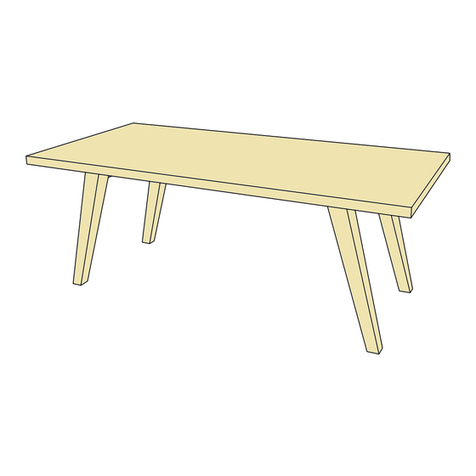
Multay
Multay AN03 Assembly instruction
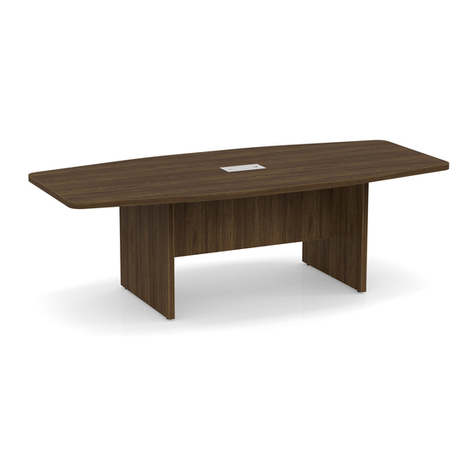
OfficeSource
OfficeSource PL236T Assembly instructions

Peka
Peka SLIM 450 Assembly instruction

Home Decorators Collection
Home Decorators Collection SK19326Br1-B Use and care guide
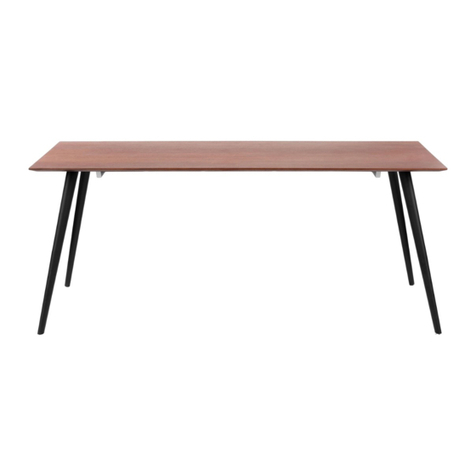
MAD
MAD airfoil G28T quick start guide
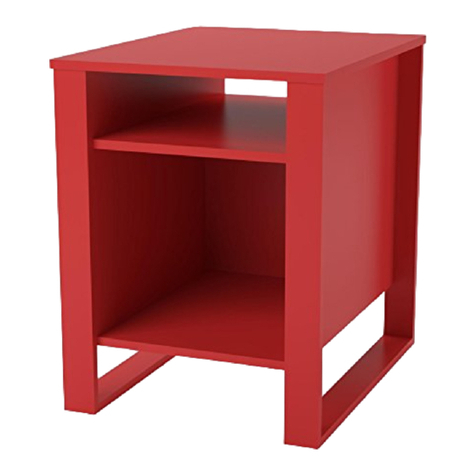
Dorel
Dorel Ameriwood Industries 3595317PCOM manual
